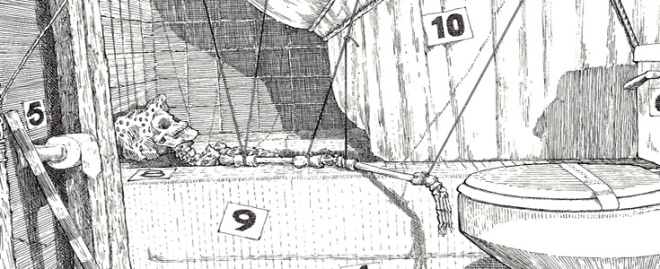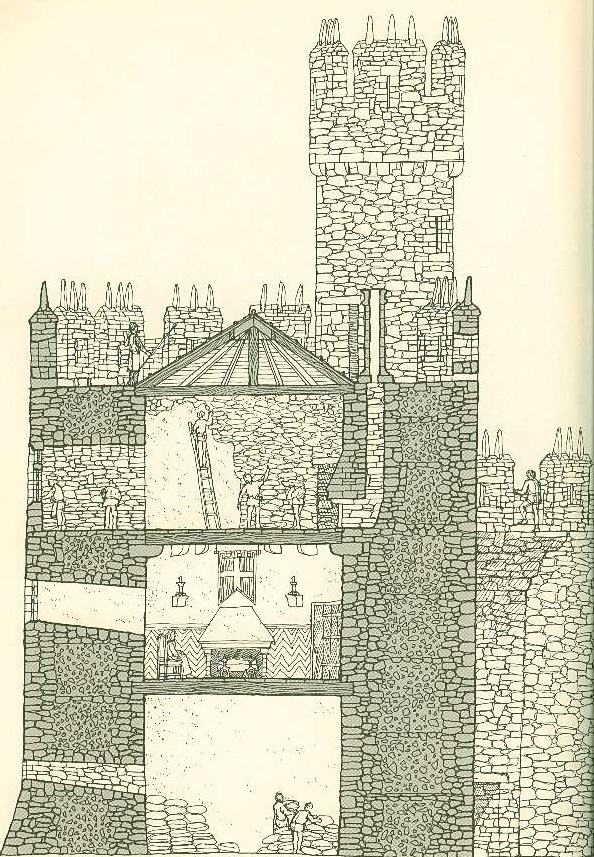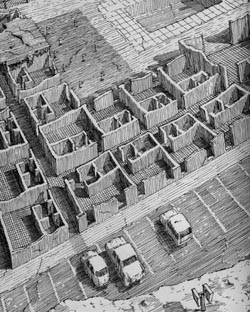While I was back in the US last spring, I got a wonderful gift: a copy of the HP Lovecraft Historical Society‘s The Curious Sea Shanty Variants of Innsmouth, Mass. This is a book-and-CD package, but it’s the book I really want to talk about. (Actually, I guess the CD is called The Curious Sea Shanties of Innsmouth, Mass.)
So, first the CD: longtime friend and collaborator-on-an-upcoming project Jesse Merlin performed on some of the songs on here; between this, Dreams in the Witch House and Re-Animator: The Musical he seems to be establishing a pattern of disturbing outline. Anyway, according to the liner, these are reconstructions of traditional Innsmouth shanties, sea songs and hymns rendered by the Miskatonic University Men’s Chorus. This song isn’t actually on the album:
They are fun, and they sound lovely, but it’s actually the book I want to talk about, because it’s the book that I found really impressive. It’s presented as a humanities monograph published by Miskatonic University Press in 1927, and it’s got a lot of lovely period detail, from the slightly blurry colour maps to the typeface.
The book (well, pamphlet, really — 46 pages) starts with an overview of both the history of Innsmouth from Lovecraft’s “The Shadow Over Innsmouth” and of sea shanties and sea songs in general, as well as the story of how the author became acquainted with them. We then get the lyrics and explanatory notes for 14 songs, most of them variants on well-known sea songs like “Old Maui,” “Leave Her Johnny,” “Blow the Man Down” or “New York Girls.” You have to be careful with this kind of thing — you’re always on the verge of filk with any sort of reinterpretation here, but it helps that there are so many different variants of these songs to start with, that the rewrites are restrained enough not to cover the lyrics in tentacles, and that the original lyrics are often a little weird to start with — there are a lot of damned peculiar things you can do with a drunken sailor, it turns out.
On a personal note, Jesse and I went to school together, and at a young age we went on one of those living-history things where we had to learn sailor-y type skills aboard the C. A. Thayer at the Hyde Street Pier Maritime Museum in San Francisco. I still remember ensnaring a passing student with a thrown monkey’s fist while practicing at school, a feat that would have been even more impressive if I hadn’t been trying to wrap my line around a basketball hoop some distance from the kid. But my point is that the bo’sun, Roy, did in fact lead the class in singing sea shanties, including several of the ones that appear in this book. At the time, he seemed like a salty old sea dog to me, although it was the 1980s so there’s also the possibility he was just a big Stan Rogers fan.
From the songs we then move on to some analysis, followed by a brief piece on the Esoteric Order of Dagon itself (in the words of Albert Wilmarth, who is of course the protagonist of “The Whisperer in Darkness.” After that, some speculation about where the “Kanaky” referred to in the shanties actually is. (This is why I was surprised that there wasn’t a variant of “John Kanaka” in this collection! I mean, look at the lyrics.)
What’s interesting to me is not only the fake-history aspect of this — as we have previously established, I love fake history — but the way in which it ties in to other bits of fake history. Obviously, there’s Lovecraft’s whole New England setting, but there’s also the list of other monographs which includes one written by Peter Dannseys (an anagram of Call of Cthulhu creator Sandy Petersen) together with Eliphas Fallworth (which makes no sense unless you know, as I do, that Eliphas’s middle name is “Cordvip,” making his name an anagram of “Howard Phillips Lovecraft”). Chaosium products referring to Miskatonic University from the 80s and maybe 90s often included these faculty members. There were loads of them: Eric K. Larkhan (Charlie Krank), Herbert Hike (Keith Herber), L. N. Isinwyll (Lynn Willis), F. Ford Ratsegg (Greg Stafford), Ivan Mustoll (Tom Sullivan), etc., etc. I can’t believe I remember them, actually. But there are probably not a lot of people who do, unless they’ve come back into use in the decade or so in which I’ve not been paying a lot of attention to Call of Cthulhu. But it’s that level of detailed nerdery you want and get from the HPLHS. I haven’t got the patience for that kind of thing, but boy do I respect it in others.
In fact, this might be one of those things that it does my heart good to know exists. I may hate on all the collectible-Cthulhu stuff there is out there now — just old-guy stuff, you know, grumbling about everything being a marketplace — but the HPLHS have paid their dues; hell, I first heard of them back in the 90s in that Unspeakable Oath article, which I must have read 100 times. And they do it with such labor-of-love attention to detail.
So, yeah. Another oddball pamphlet for my oddball pamphlets shelf. If you like this kind of thing, you will like this thing. Get you one.
Also: in “Old Maui,” the singer says: “it’s a damn tough life, full of toil and strife, we whalermen undergo.” But the first version I heard sounded a lot like “we whalemen,” and even though it’s still clear that means the crew of a whaling ship, I can’t help but think of it as “whale-men.”








